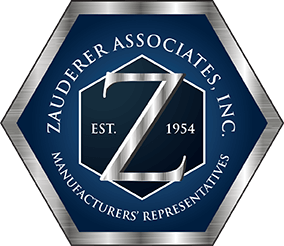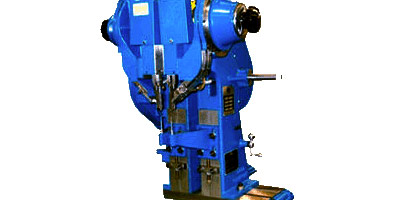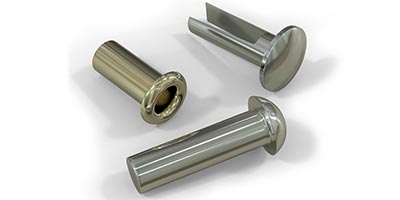Zauderer Associates has expertise in automated rivet setting equipment and rivets. Let us help you with any projects you have, whether to find the right standard fit or customized to your exact needs.
The manufacturer that we partner with focuses on providing competitive prices and high quality products. No matter how complicated your fastener project and product may be, the engineering expertise provided will make your project a success.
Some Of The Industries We Serve:
Appliance, Commercial Cooking & Food Services, Construction, Electrical, Furniture, Medical, Transportation
Riveting & Riveting Machines
Introduction to Custom and Standard Cold Headed Parts
Custom cold formed parts and fasteners are available for even the most unique and challenging fastening requirements. Cold heading is a process where the parts are created by exerting extreme pressure through a die. Since there is a no scrap loss, there is significant cost savings that can be passed on to the customer. There are many other advantages of cold heading over machining, which include its repeatability, high tolerances, and ability to produce customized and intricate shapes and forms. No matter how unique or complicated your fastening requirement might be, we can work with you to find a custom component part that works for your product.
Materials of Standard and Custom Rivets Available
- Aluminum
- Brass
- Carbon Steel
- Copper
- 302 Stainless Steel
- 410 Stainless Steel
- 430 Stainless Steel
- Additional Alloys Available
Rivet Finishes Available
- Anodizing
- Black Oxide
- Brass Plating
- Copper Plating
- Galvanized
- Gold Plating
- Nickel
- Painted / Japanning
- Silver Plating
- Zinc
How to design a rivet for your unique requirements?
There are many choices to consider when designing a customer rivet or choosing a standard rivet. Specifications to consider include diameter, length, materials, and finishes. Depending on the end use for the rivet, some of these specifications may be at least partially determined by regulation. We can create customized rivets according to the design specifications below:
- Rivet Diameter: Ranging from .03 in/.762 mm to .562 in/ 14.275 mm
- Rivet Length: Maximum of 5 in/127 mm
- Rivet Materials: Aluminum, Brass, Carbon Steel, Copper, Stainless Steel, and Alloys
- Rivet Finishes: Anodizing, Black Oxide, Brass Plating, Copper Plating, Galvanized, Gold Plating, Nickel, Painted/Japanning, Silver Plating, Zinc
Zauderer Associates, Inc. has years of experience and expertise to ensure that all your requirements are met.
How to select the proper rivet machine?
The first step is to determine whether you need a machine that does impact riveting, orbital riveting or radial riveting:
- Impact riveting – drives the rivet downwards through the materials in a forming tool known as a rollset. The rollset cause the rivet to flare out. This type of riveting is very fast and can attach a rivet in less than a second.
- Orbital riveting – a spinning tool called a peen is pressed down into the rivet. This type of riveting takes 2-3 second per rivet but offers a bit more control over the entire riveting process.
- Radial riveting – this is similar to orbital riveting but is a much slower process that allows even easily fractured ceramics to be riveted with a high quality bond.
The second step is to determine the type of machine that should be used. There are various choices here as well:
- Motor-driven riveting machines – produce a significant amount of force to install the rivet. These rivet machines come in single, dual head or multiple head models so that multiple rivets can be installed at once.
- Pneumatic riveting machines – produce less force and torque than a motor-driven machine but the force can be precision tuned to accommodate different materials. These rivet machines also come in single, dual head or multiple head models so that multiple rivets can be installed at once.
- Custom riveting machines – machines with both motor-driven and pneumatic capabilities can be developed. We specialized in providing customized riveting machines that are specific to your required diameter, length, and production requirements.
Where do you purchase a riveting / rivet machine?
Purchasing a riveting machine can be a large time and money investment and therefore there are many reasons why we believe you should consider partnering with Zauderer Associates to source your machine:
- Our riveting machines are proudly made in the USA and all repairs, customer service, and technical support are carried out in the same location.
- Customer support will help to troubleshoot any issues and you will have easy access to any rivet machine repair parts that may need replacement.
- Choosing the exact specifications of your machine can be complicated. Let Zauderer Associates take the guesswork out of the process and partner with you and the manufacturer to pick a standard rivet machine or help to design a custom rivet machine that meets your production and manufacturing requirements.
How do rivets work?
Rivets are unique from threaded fasteners in the way that they attach pieces of metal together. Rivets have a head, a cylindrical shaft and a tail. When installed, the tail of the rivet will be compressed or deformed so that it spreads out or expands to hold the rivet in place. The finished product will look somewhat like a dumbbell shape upon the completion of the riveting process. Since there ends up being a head on both sides of the metal or materials being placed together, the strength of finished product is very reliable and secure.
Can you install rivets without a rivet machine or gun?
The type of rivet and the product will alter our recommendation for how to install the rivet. Additionally, it depends on if the project will be high volume or not. While we do have manual rivets available, this is best for light assembly and low volume production. Once we understand the product and all the production needs then we can recommend the type of riveting that should be used, whether impact riveting, orbital riveting, or radial riveting. Additionally, there are many types of machines available including both motor-driven riveting machine and a pneumatic riveting machine. We are also able to help design a custom riveting machine that may even have both motor-driven and pneumatic capabilities.
When to use rivets instead of screws?
The primary purpose of rivets is to fasten objects together in a reliable, strong, and economical way. While there are many different types of rivets, each with unique characteristics, rivets are often the best choice when resistance to vibration is required. Other advantages of riveting include that they provide an option when low-profile heads are needed, they are very durable and are easy to install, especially when a proper machine is used. Additionally, solid rivets are one of the strongest types of fasteners available, which is why solid rivets are used for aircraft, bridges, and other applications where strength is critical.
Specific Product Applications for Customized Rivets and Cold Head Parts
Rivets and cold headed parts can be seen in a variety of industries and products. Below are just a few examples of industries and products where our standard and customized rivets and cold headed parts can be found:
- Sheet metal fabrications
- Electrical components
- Cutlery
- Automotive
- Furniture


